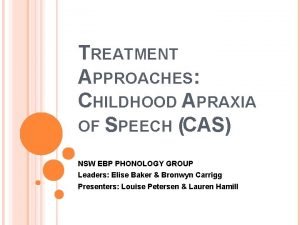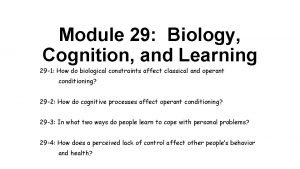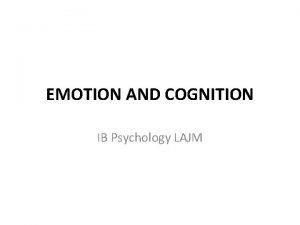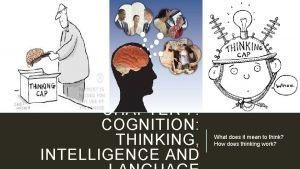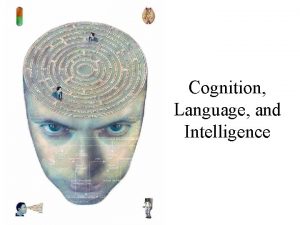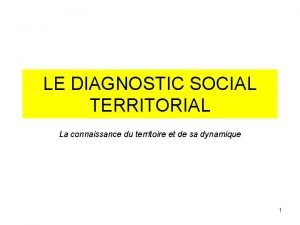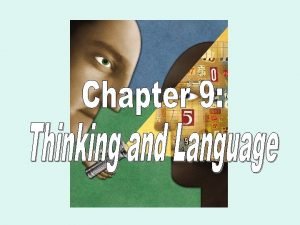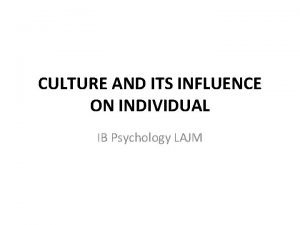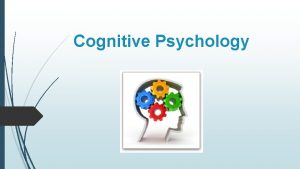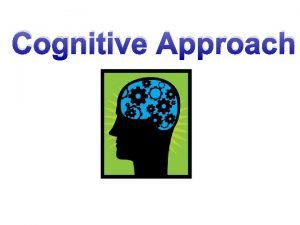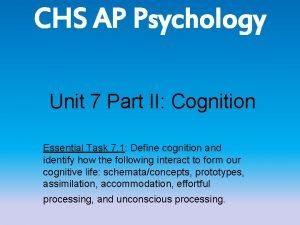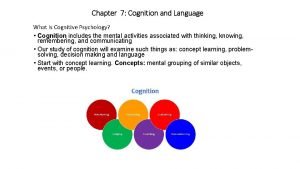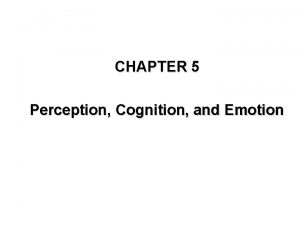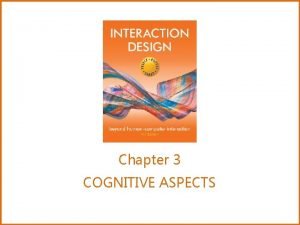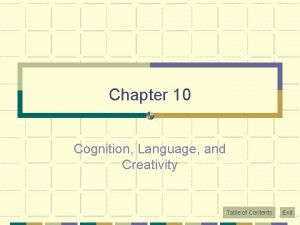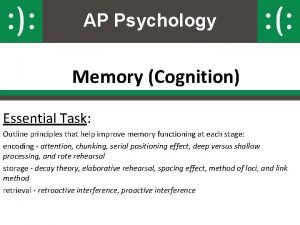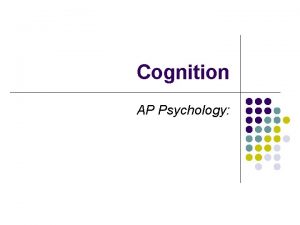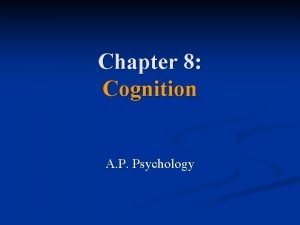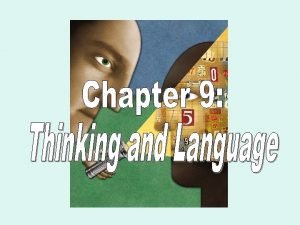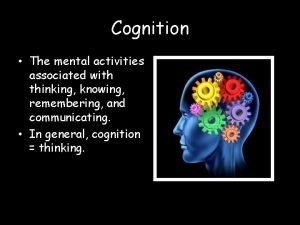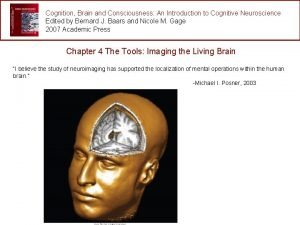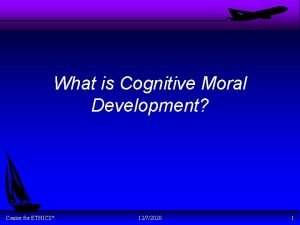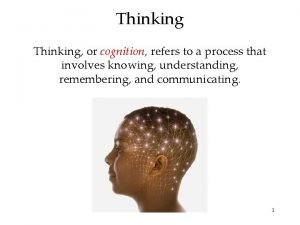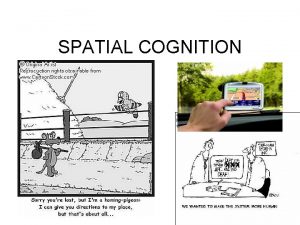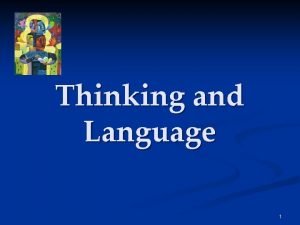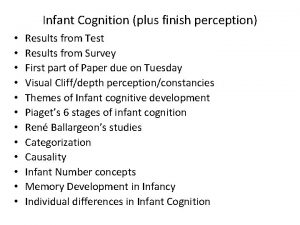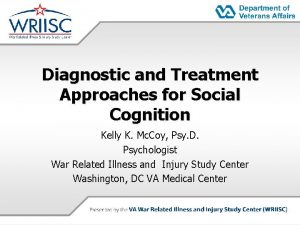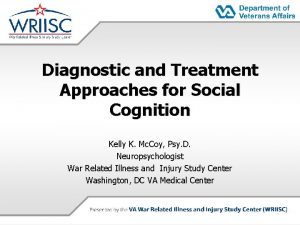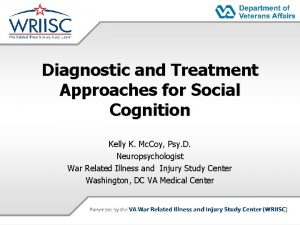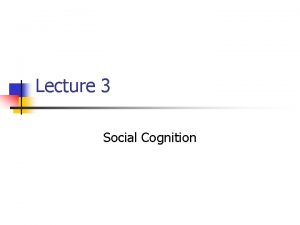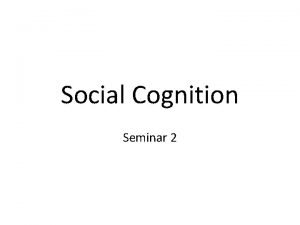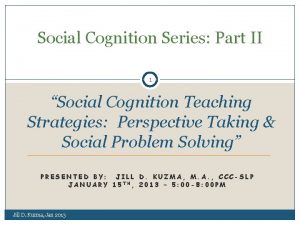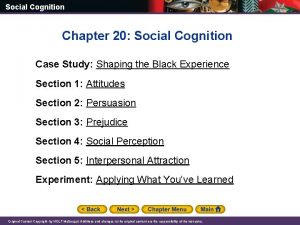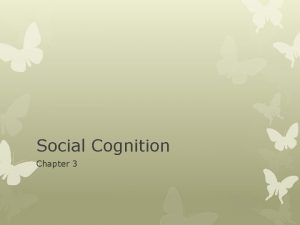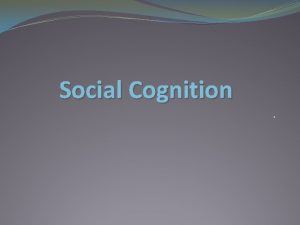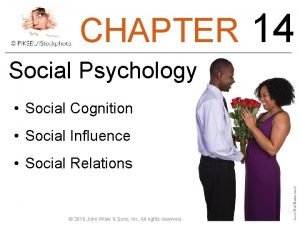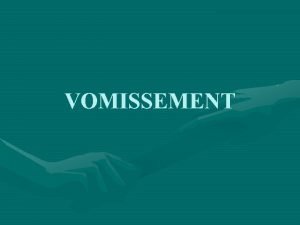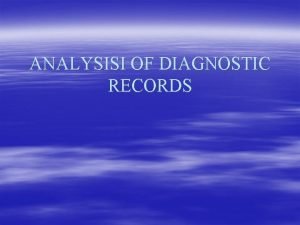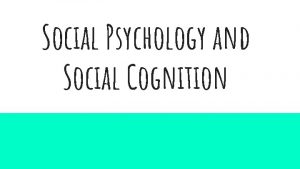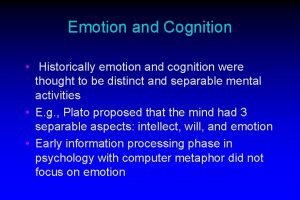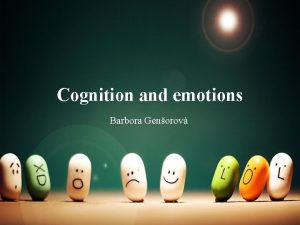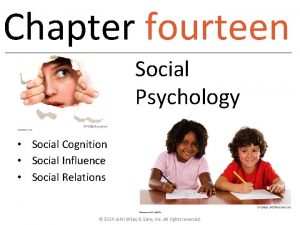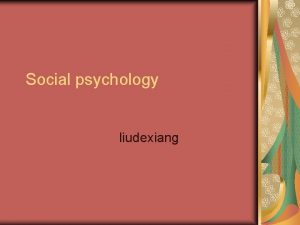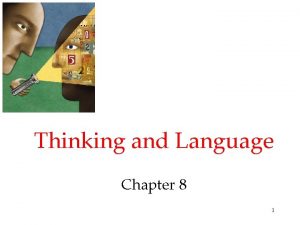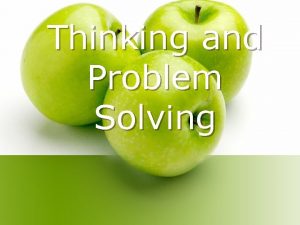Diagnostic and Treatment Approaches for Social Cognition Kelly


































- Slides: 34

Diagnostic and Treatment Approaches for Social Cognition Kelly K. Mc. Coy, Psy. D. Neuropsychology Postdoctoral Fellow War Related Illness and Injury Study Center Washington, DC VA Medical Center

What is social cognition?

Social Cognition in TBI § “Historically, it is often the physical manifestations of a brain disorder that are the first to be described in the scientific literature and to be clinically treated. Some decades later, the cognitive impairments are recognized. Yet, it is the emotional and behavioral changes that are the most significant barriers to effective functioning in family, in work, in school and in other settings. ” (Judd, 1999)

TBI Adjustment and Rehabilitation § Long-term adjustment and rehabilitation following TBI are better predicted by psychosocial competence than by cognitive or physical sequelae (Bornhofen & Mc. Donald, 2008). § Social deficits following TBI are thought to reflect cognitive deficits.

What is social cognition? § Brain-behavior factors involved in processing social information § Includes encoding, storage, retrieval, and organization of socially-salient information § Emphasizes emotional factors rather than “cold cognition”

Brain Structures § Brain structures involved in social processes include: § Higher-order sensory cortices § Amygdala, striatum, and orbitofrontal cortex § Higher cortical regions

The Social Brain From Blakemore, S. J. (2008). The social brain in adolescence. Nature Reviews Neuroscience, 9, 267 -277.

Social Cognition - Perception § Face perception § Face identification § Facial expression § Eye gaze § Prosody § Biological motion § Dynamic emotion

From Tottenham, N. , Tanaka, J. , Leon, A. , Mc. Carry, T. , Nurse, M. , Hare, T. , Marcus, D. , Westerlund, A. , Casey, B. , & Nelson, C. (2009). The Nim. Stim set of facial expressions: Judgments from untrained research participants Psychiatry Research, 168, 242 -249.

Post-Perceptual Processing § After perceiving social cues, the brain makes associations and inferences § “Automaticity” of emotional processing § Associations and inferences assigned to the stimuli influence other cognitive processes: § Memory § Attention § Decision making

Nonconscious Processing All-Ireland Road Bowls championship from Hatfield, E. , Cacioppo, J. T. , & Rapson, R. L. (1994). Emotional contagion. Paris: Cambridge University Press.

Higher Level Processing § Theory of mind § What is the other person thinking? § Metacognition § Am I thinking about this in an effective way? § Social reasoning § Is he being deceptive? § Is this a good bet? § Should I cooperate with these people?

Assessment § Interview § Ask patient and family members/caregivers § Insight into impairments may be an issue § Ask about social difficulties and strengths § § § Understanding what others mean Frequent misunderstandings Small talk Getting needs met in social situations Social avoidance and social failure behaviors § Behavioral observations § Wonder, how is this behavior related to brain function?

Assessment § Neuropsychological tests § Advanced Clinical Solutions for the Wechsler Adult Intelligence Scales – Forth Edition § The Awareness of Social Inference Test § Experimental paradigms § FAR, BLERT, MSCEIT, point-light displays § Need for improved assessment methods § Treatment limited by insufficient assessment

Research Findings: TBI and Social Cognition § Social functioning deficits following TBI § Loss of employment, constricted social networks, strained intimate relationships § Social cognition deficits following TBI § Emotion detection, theory of mind, sarcasm detection, empathy § Difficulty interpreting body posture, tone of voice § Deficits both early after injury and at one-year follow up - persistent and “direct effect of brain injury” (Ietswaart, Milders, Crawford, Currie & Scott, 2008)

Deployment TBI § Age at injury § Adolescent brain and social cognition § Psychopathology and social cognition § PTSD, depression, anxiety § Insult related risk and resilience factors § Type of insult, pathophysiology of insult, post-insult environment § Non-insult related risk and resilience factors § Pre-morbid cognitive and psychological functioning, SES, sociocultural context, legal issues, family functioning

Research Findings: Psychopathology and Social Cognition § § § § Schizophrenia Autism Depression Anxiety Antisocial Personality Disorder Bipolar PTSD

What could possibly go wrong?

Social Cognition Rehabilitation

Group Members § TBI/PTSD diagnosis § Difficulty reading social cues, understanding other people’s intentions, making sense of conflicting social cues, and managing emotions in social situations. § Social cognition complaints run the gamut from difficulty connecting emotionally with one’s spouse to trouble accomplishing basic goals in formalized social settings.

Social Cognition Rehabilitation § Weekly, 60 -90 minutes, 2 -6 veterans, cofacilitated by neuropsychology and speech § Heterogeneous groups § Divided by expressive language abilities § Neuropsychotherapy approach § Combined psychotherapy and cognitive rehabilitation § Structured sessions § Review homework, new topic, role play, assign homework

Techniques § § § Psychoeducational handouts Videotaping and mirrors Role plays Real life examples Inclusion of friends and family Homework activities

Social Cognition Triangle Your Actions Your Emotions or Mood Your Thoughts From Roberts, D. L. , Penn, D. L. , & Combs, D. R. (2006). Social Cognition and Interaction Training Treatment Manual.

Adapted from Powel, T. , & Malia, K. (2003). The brain injury workbook: Exercises for cognitive rehabilitation. Milton Keynes, U. K. : Speechmark Publishing.

Group Modules § Emotion Perception and Expression § Identity and Readjustment § Social Problem Solving

Emotion Perception and Expression Defining emotions Recognizing emotions in oneself Static emotion perception – facial expressions Dynamic emotion perception – body language, tone of voice Reading social inferences: Sarcasm, humor and sincerity Mimicry Understanding the social context Gathering social information Social self-awareness: Eye contact, tone of voice, body language, facial expressions

Identity and Readjustment What happened to me? Understanding your injury Who am I now? Changes, strengths, & weaknesses Who do I want to be? Psychosocial goals Military identity & social norms Civilian identity & social norms Ability & disability Advocating for yourself Parenting Significant other relationships Rediscovering role functioning

Social Problem Solving Give & take in conversations Empathy & active listening Assertiveness Topic maintenance Asking for & accepting help Strategies for self-calming Setting social goals Explaining your injuries to other people Dealing with difficult situations: Unexpected outcomes, rudeness & uncertainty Managing stigma and misperceptions about TBI and PTSD

Issues of Special Importance § Vulnerability to exploitation § Small talk § Self disclosure § Hopelessness § Socializing without alcohol

Take Home Points § Social functioning is critical to recovery and adjustment following TBI. § Assess for cognitive deficits, including social cognition. § Do not underestimate the importance of including friends, family, and caregivers in treatment. § Anchor treatment in goals that are important to the patient.

Take Home Points § Consider social cognition when communicating with a patient. § Be patient – remember that an expressed emotion may be unintended or based on inaccurate appraisal of the situation. § Clarify – “Can you repeat back what I am trying to convey? ” “Is there something I missed? ” § Address nonverbal communication verbally – “How do you feel today? ”

Take Home Points § The patient may have specific deficits, but is an adult. § Communicate respect § Try to understand specific deficits and strengths § Design a treatment plan that remediates and/or compensates for deficits and plays to strengths

Take Home Points § In addition to TBI, co-morbid psychopathology may contribute to cognitive difficulties and difficulties in social functioning. § Take a team approach and refer to appropriate providers. § Primary care, neurology, physical medicine and rehabilitation, neuropsychology, speech language therapy, occupational therapy, sleep medicine, recreation therapy, social work, driver’s rehabilitation, audiology, vision, individual and family therapy, legal advocacy, supported employment , substance abuse treatment, complimentary and alternative medicine

And remember…
 Konsep ketersediaan heuristik
Konsep ketersediaan heuristik Cas treatment approaches
Cas treatment approaches Chapter 7 cognition thinking intelligence and language
Chapter 7 cognition thinking intelligence and language Module 29 biology cognition and learning
Module 29 biology cognition and learning Teacup ib psychology
Teacup ib psychology Chapter 7 quiz cognition thinking intelligence and language
Chapter 7 quiz cognition thinking intelligence and language No word
No word Cognition and personalization
Cognition and personalization Isolement social diagnostic infirmier
Isolement social diagnostic infirmier Exemple diagnostic social territorial
Exemple diagnostic social territorial Belief perseverance
Belief perseverance Thought content descriptors
Thought content descriptors Serial 7s or 3s
Serial 7s or 3s Magec psychology
Magec psychology What is cognition
What is cognition Cognition definition
Cognition definition Embodied cognition ap psychology definition
Embodied cognition ap psychology definition What is cognition
What is cognition Objectives of perception
Objectives of perception Altered cognition in older adults is commonly attributed to
Altered cognition in older adults is commonly attributed to What is cognition
What is cognition Cognition definition
Cognition definition Priming memory examples
Priming memory examples Psychology unit 7
Psychology unit 7 Embodied cognition ap psychology definition
Embodied cognition ap psychology definition Availability heuristic ap psychology
Availability heuristic ap psychology Embodied cognition ap psychology
Embodied cognition ap psychology Cognition refers to
Cognition refers to All the mental activities associated with thinking
All the mental activities associated with thinking Consciousness
Consciousness Moral cognition
Moral cognition Cognition refers to:
Cognition refers to: Hippocampus taxi drivers
Hippocampus taxi drivers Linguistic determinism
Linguistic determinism Cognition plus
Cognition plus

